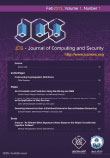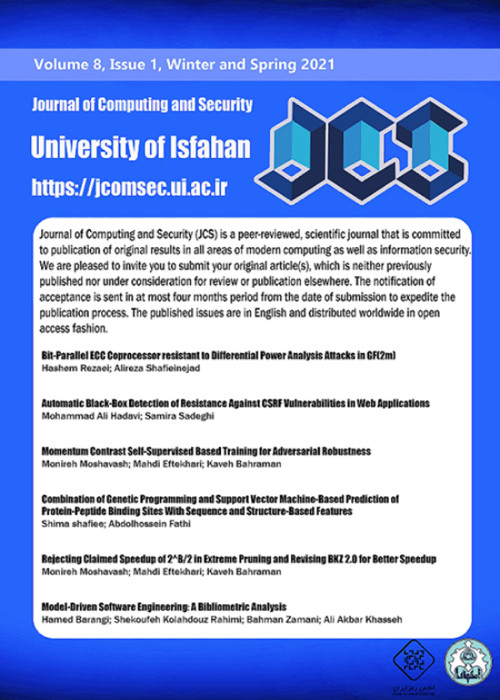فهرست مطالب

Journal of Computing and Security
Volume:1 Issue: 2, Spring 2014
- تاریخ انتشار: 1393/02/20
- تعداد عناوین: 7
-
-
Page 81
-
Pages 83-93An architect designs software using architectural styles and quality attributes. To satisfy quality attributes, architectural tactics are used. An architectural tactic determines how to implement a quality attribute in architectural styles. The interaction between architectural tactics and architectural styles plays an important role in meeting quality attributes. In this article, the interaction between architectural tactics, namely availability and performance, and architectural styles, namely pipe & filter, layered, blackboard, client-server and broker is evaluated, and then, a new ranking scheme for the architectural styles is proposed. Through this scheme, the best architectural style maybe obtained for every individual quality attribute or their combinations.Keywords: Software Architecture, Quality Attributes, Availability, Security, Performance
-
Pages 95-109Tourism is one of the major sources of income for many countries and with the advent of internet, using this new channel (internet) for providing different services of tourism, i.e., e-tourism, is growing rapidly. This is also the case in Iran, but it is clear that focusing on technology alone cant lead the business to success. The key point of successful business in e-tourism is to concentrate on the customers and their behavior for having a better relationship with them. This study is intended to develop a model based on Decomposed Theory of Planned Behavior (DTPB) that considers influential factors to predict and evaluate intention of tourists and travelers while using e-tourism services and websites, such as www.expedia.com and www.priceline.com. The influential factors are studied and investigated through a survey with 259 responses. Structural Equation Modeling (SEM) has also been utilized for testing relevant hypotheses to either include or thwart specific factors which drive people to use e-tourism services provided in e-tourism websites. The results show that Subjective Norm and Perceived Behavioral Control significantly affect Iranian customers intention to use e-tourism (i.e., the websites which offer tourism services). In this research we not only worked on evaluating a model and the relationship between constructs, but also tried to find specific factors that drive people to use e-tourism. So, besides DTPB factors, we found that Curiosity has more effect on tourist intention. The findings have implications for Iranian tourism companies to predict the behavior of tourists when they are using the e-tourism, and also develop the CRM methods in e-tourism websites.Keywords: E, Tourism, Consumer Behavior, Decomposed TPB Model, Curiosity
-
Pages 111-122we propose in this article a new hybrid method for modeling accurate fuzzy rule based classification systems. The new method is a combination of manifold based data mapping method, a heuristic fuzzy rule based construction method and an evolutionary based rule weighting approach. Manifold based data mapping method considers the intricate geometric relationships that may exist among the data and computes a new representation of data that optimally preserves local neighborhood information in a certain sense. Although this new representation does not secure the interpret ability of obtained fuzzy models, the main intention of this research is to improve the classification accuracy significantly. Experiments on some well-known datasets are performed to show the performance of the new proposed approach. Some nonparametric statistical tests are used to analysis the results obtained in experiments. Experimental results confirm the effectiveness of our proposed method in improvement of the classification accuracy.Keywords: Fuzzy Rule Based Classification Systems, FRBCSs, Manifold Learning, Rule Weighting, Genetic Network Programming, GNP
-
Pages 123-132Machine translation is considered as a branch of machine intelligence with about fifty years background. Ambiguity of language is the most problematic issue in machine translation systems, which may lead to unclear or wrong translation. One of the problems involved in natural language processing is the semantic and structural ambiguity of the words. The objective of this paper to focused on the word sense disambiguation. In here, the existing algorithms for word sense disambiguation are evaluated and a method which is proposed based on the concept, structure and meaning of the words. The experimental results are promising and indicate that this proposed approach significantly outperform its counterparts in terms of disambiguation accuracy.Keywords: Natural Language Processing, Word Sense Disambiguation, Text Mining
-
Pages 133-158In this paper, we introduce a new class of association rules (ARs) named Multi-Relation Association Rules which in contrast to primitive ARs (that are usually extracted from multi-relational databases), each rule item consists of one entity and several relations. These relations indicate indirect relationship between entities. Consider the following Multi-Relation Association Rule where the first item consists of three relations live in, nearby and humid: Those who live in a place which is near by a city with humid climate type and also are younger than 20 → their health condition is good. A new algorithm called MRAR is proposed to extract such rules from directed graphs with labeled edges which are constructed from RDBMSs or semantic web data. Also, the question how to convert RDBMS data or semantic web data to a directed graph with labeled edges? is answered. In order to evaluate the proposed algorithm, some experiments are performed on a sample dataset and also a real-world drug semantic web dataset. Obtained results confirm the ability of the proposed algorithm in mining Multi-Relation Association Rules.Keywords: Data Mining, Knowledge Discovery, Association Rules, Multi, Relation Association Rules, MRAR, Copulative Entity, Endpoint Entity, ItemChain
-
Pages 159-167This paper deals with linear programming problem with interval numbers as coefficients to exhibit with uncertainty. Since, the set of common intervals is not a field, we define generalized interval numbers to produce an algebraic interval field and on this field, we propose principle of uncertainty traverse instead of extension principle which permits to define operators on intervals exactly similar to the same operators on real numbers. In addition, we apply a total order on this field to transform interval linear programming into a traditional problem. The proposed order can be extended either pessimistically or optimistically. The numerical experiments are given to demonstrate the efficiency of the proposed scheme in comparison with the previous established works. The approach in this paper can be generalized to fuzzy linear programming problems taking the fuzzy cuts into account.Keywords: Interval Field, Interval Linear Programming, Total Ordering, Ranking Functions


